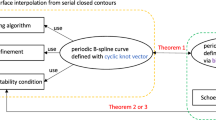Abstract
The objective of this research is to develop a surface joining method for constructing multi-looped surfaces. Based on this method, surfaces can be self-joined or inter-joined on loops to construct multi-looped surfaces. A loop is a continuous and closed boundary on a surface. By constructing one or several single-looped B-spline surfaces, multi-looped surfaces are constructed through loop joining of boundary curve segments. Loop joining is completed by merging the control points on the surface boundaries of B-spline surfaces. With the merging of data structures simultaneously, the consistencies of geometry and topology are kept in the surface model.
The proposed method for constructing multi-looped surfaces has the advantages that it is conceptually explicit, simple for user understanding and easy for system programming, and there is no computation of surface/surface intersections involved, thus no numerical solutions for nonlinear equations are required.
Similar content being viewed by others
References
Piegl, L.; Tiller, W. (1989) Curve and surface construction using rational B-splines, Computer Aided Design, 19, 9, Nov. 485–498
Kato, K. (1991) Generation of N-sided surface patches with holes, Computer Aided Design, 23, 10, 676–683
Semwal, S. K.; Armstrong, J. K.; Dow, D. E.; Maehara, F. E. (1994) Multimouth surfaces for synthetic actor animation. The Visual Computer, 10, 388–406
Casale, M. S. (1987) Free-form solid modeling with trimmed surface patches, IEEE Computer Graphics & Applications, Jan. 33–43
Chiyokura, H. (1988) Solid Modeling with DesignBase, Addison-Wesley, Reading, MA
Choi, B. K. (1991) Surface Modeling for CAD/CAM, Elsevier
Sheng, X.; Hirsch, B. E. (1992) Triangulation of trimmed surfaces in parametric space, Computer Aided Design, 24, 8 Aug. 437–444
Piegl, L. A.; Richard, A. M. (1995) Tessellating trimmed NURBS surface, Computer Aided Design, 27, 1, Jan. 16–26
Rogers, D. F.; Adams, J. A. (1990) Mathematical Elements for Computer Graphics, McGraw-Hill
Boehm, W. (1980) Inserting new knots into B-Spline Curves, Computer Aided Design, 12, 4, July, 199–201
Barry, P. J., Goldman, R. N. (1988) Recursive proof of Boehm's Knot insertion technique, Computer Aided Design, 20, 4, May, 181–182
deBoor, C. (1972) On calculating with B-Splines, Journal of Approximation Theory, 6, 50–62
Farin, G. (1990) Curves and Surfaces for Computer Aided Geometric Design, Academic Press, New York
Piegl, L. (1986) Representation of rational Bezier curves and surfaces by recursive algorithms, Computer Aided Design, 18, 7 Sept. 361–366
Lin, C. I. (1994) Computed aided surface design using a plane model, MS thesis, National Chung-Hsing University, June
Author information
Authors and Affiliations
Rights and permissions
About this article
Cite this article
Chuang, S.H., Chiou, I.Z. Constructing multi-looped surfaces by loop joining. Engineering with Computers 13, 175–183 (1997). https://doi.org/10.1007/BF01221214
Issue Date:
DOI: https://doi.org/10.1007/BF01221214




